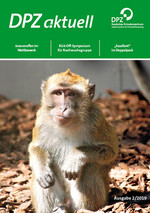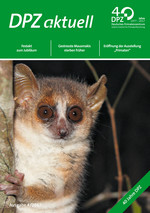Identification of a new herpesvirus
The Kaposi Sarcoma Herpesvirus (KSHV) can cause cancers like Kaposi Sarcoma (KS) and primary effusion lymphoma (PEL) in humans. Non-human primates can be infected with KSVH-related viruses. However, these viruses only cause disease in the context of immunosuppression, due, for instance, to coinfection by an immunosuppressive virus. The virus diagnostics laboratory jointly with the service unit Pathology at DPZ and the laboratory of Prof. Thomas Schulz, Hannover Medical School, have identified and characterized a novel KSHV-related herpesvirus in Colobus monkeys. The virus was named Colobine Gammaherpesvirus 1 (CbGHV1) and the structure of its genome was very similar to that of KSHV. The virus was identified in animals housed at zoological gardens and suffering from KS- or PEL-like diseases. It had spread in the animals and could be detected in malignant cells. No evidence for coinfection with an immunosuppressive virus was obtained. The results of these studies were published in two manuscripts in the renowned journal Emerging Infectious Diseases. They suggest that experimental infection of Colobus monkeys with CbGHV1 might recapitulate important aspects of KSHV infection of humans.
Chip-based diagnostics of virus infection of macaques
Viral infections of macaques and other non-human primates (NHP) can threaten the health of the animals and of humans with animal contact. Therefore, it is important for facilities which house NHP to have access to diagnostics of virus infections of NHP. At DPZ, only tests for selected agents were available and had to be carried out separately, which was labor and time intensive. The diagnostics lab at Infection Biology Unit now put into operation a chip-based system that allows parallel detection of antibody responses against nine different infectious agents. The manuscript shows that in the macaque colony screened, which is housed at DPZ, animals had only antibodies against viruses that do not cause disease or only cause mild disease. In contrast, no antibody responses were detected against herpes B virus, which poses a severe threat to human health.
Papillomavirus infection and focal epithelial hyperblasia in a bonobo
Papillomavirus infection of humans can cause benign skin lesions (low risk strains) but also cancers, like cervical cancer and oral cancer (high risk strains). A disease termed focal epithelial hyperplasia (FEH) affects mainly Eskimos and American Indians and is caused by human papillomavirus type 13 (HPV13). An outbreak of FEH has also been observed in a colony of bonobos at Antwerp zoological garden in 1987 and was associated with Pan paniscus-Papillomvirus 1 (PpPV1) infection. In 2017 the diagnostics laboratory of the Infection Biology Unit received samples from a bonobo housed at Leipzig zoological garden that was suffering from FEH and PpPV1 was detected in the afflicted tissues. Further investigation revealed that the animal was part of the bonobo colony suffering from the FEH outbreak in Antwerp in 1987. This suggests that FEH in bonobos does not undergo full remission or that several subsequent outbreaks are possible. Moreover, sequencing revealed that the PpPV1 genomes found in the FEH afflicted animal in 1987 and 2017 differed at 23 positions. Thus, the animal might either have been infected with several PpPV1 variants or the virus initially present has mutated more intensively than expected from published data.
Herpes B virus replication and viral lesions in the liver of a cynomolgus macaque which died from severe disease
Herpes B virus (Macacine alphaherpesvirus 1, family Herpesviridae, subfamily Alphaherpesvirinae, genus Simplexvirus) naturally infects macaques. Infection is usually asymptomatic or is associated with mild symptoms. However, in rare cases infected animals develop severe disease, likely due to a compromised immune system. The Infection Biology Unit described such a case: A previously healthy cynomolgus macaque, which displayed a growth arrest likely due to a previous hepatitis of unknown origin, died within 12 h from severe disease with rapid onset. Lesions containing herpes B virus particles were observed in the liver of the animal and PCR analysis revealed high copy number of the viral genome in liver, other organs and feces. These findings, which were published in Journal of Medical Primatology, suggest that the liver could be an important target organ of herpes B virus infection and that feces can be a source of infection. The study underlines that it is important to determine the herpes B virus status of macaques that have contact with humans: Healthy animals can be infected and may shed the virus but usually develop severe disease (associated with massive viral amplification) only upon induction of immunodeficiency. In contrast, transmission to humans (via bites, scratches, feces) may invariably be associated with disease, which, in the absence of treatment, can take a fatal course in about 70% of the afflicted patients.



